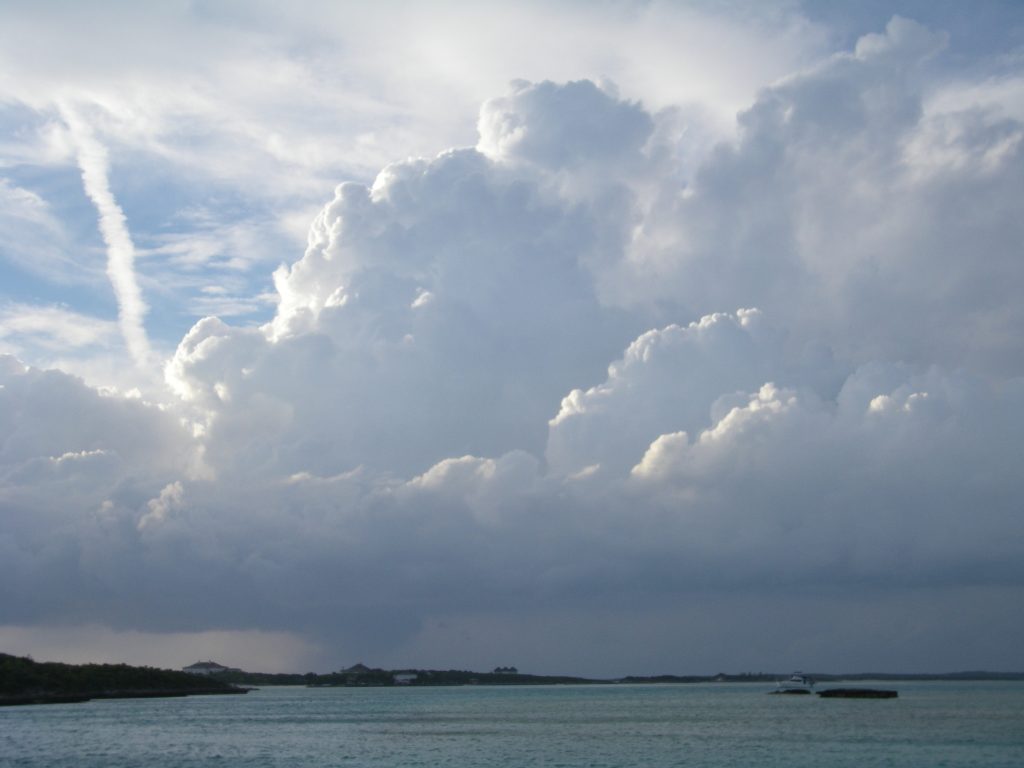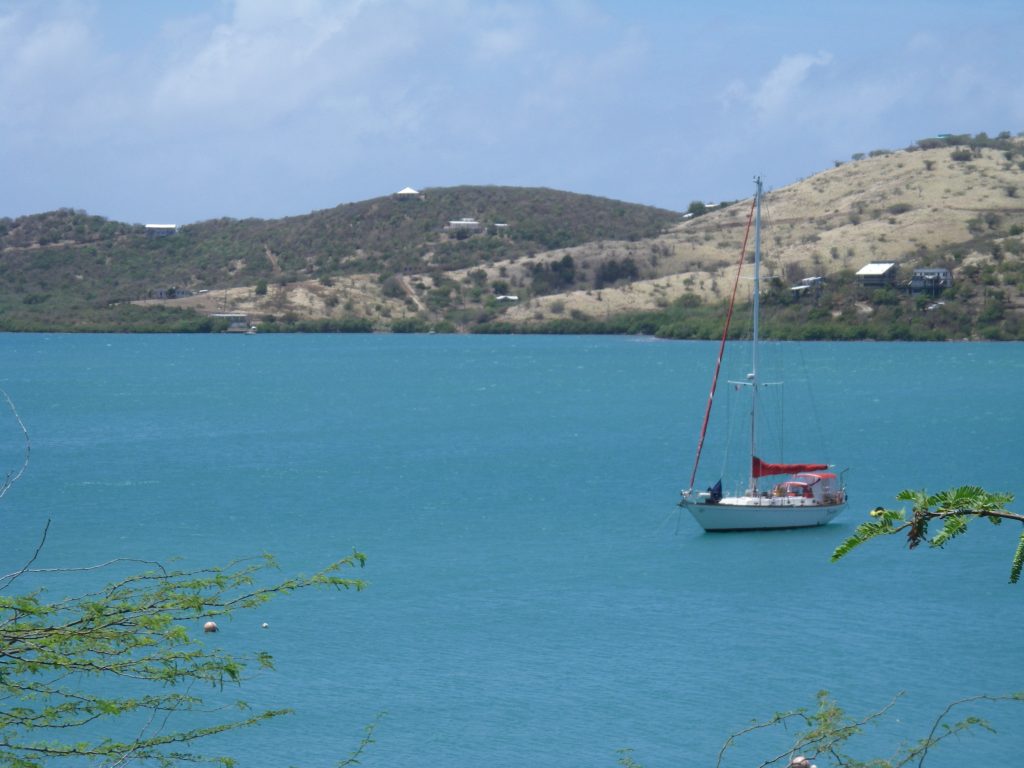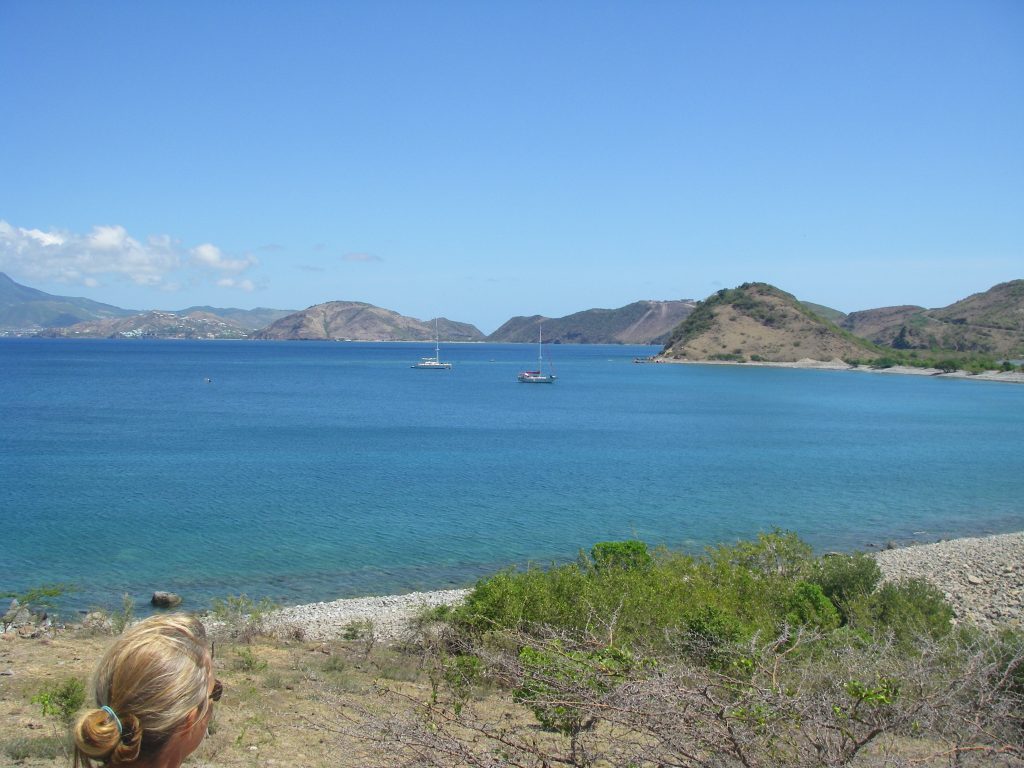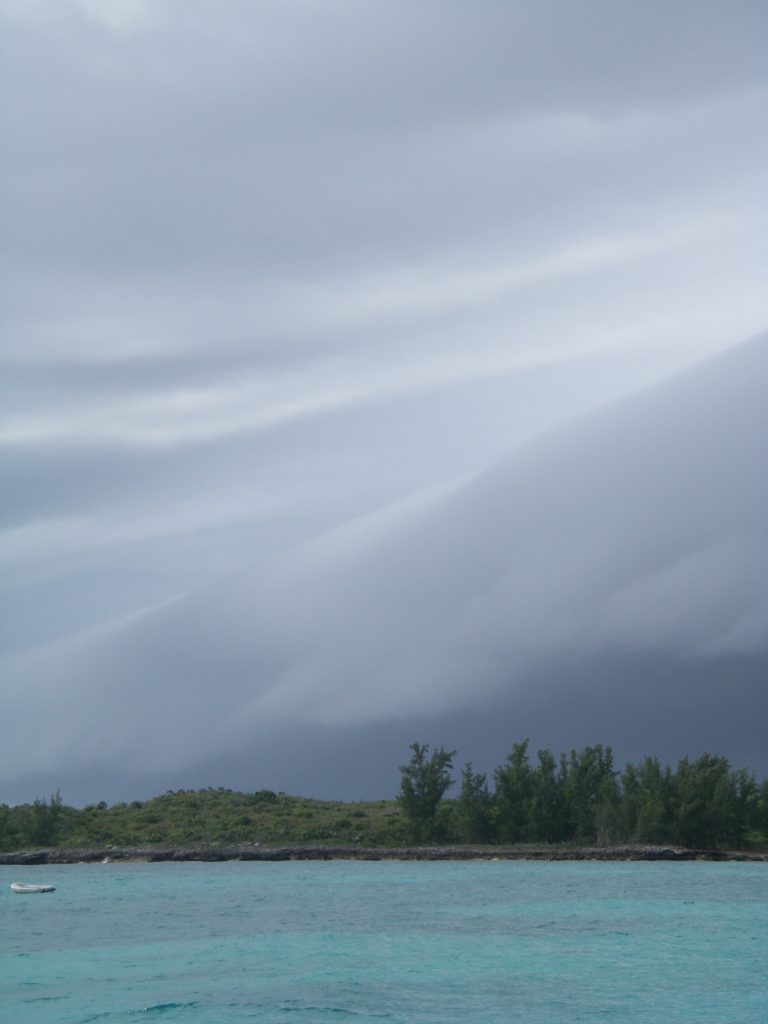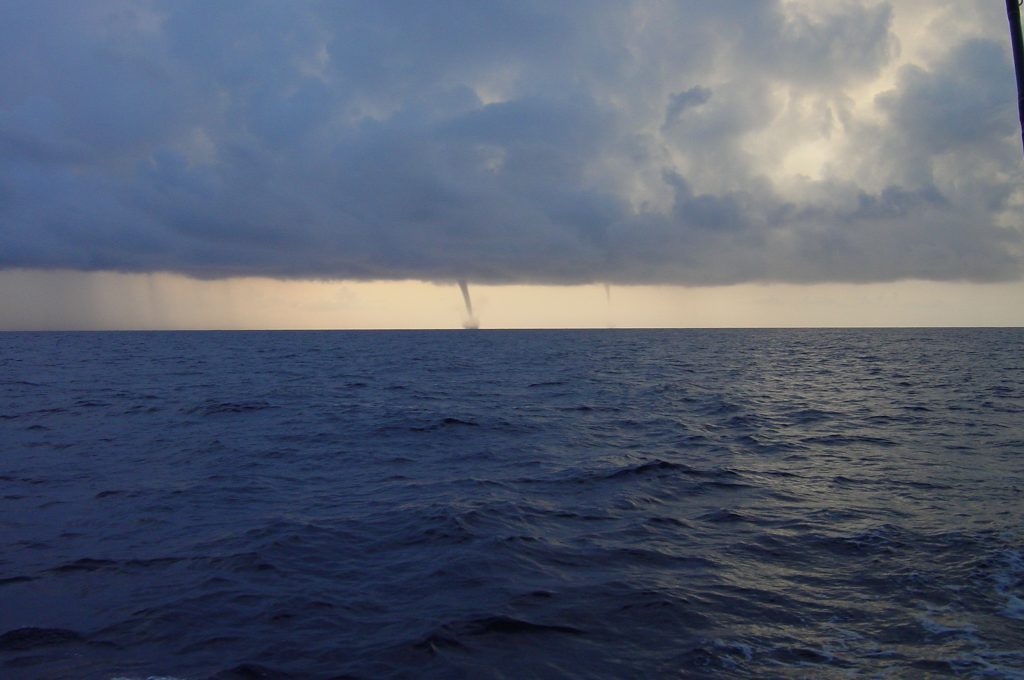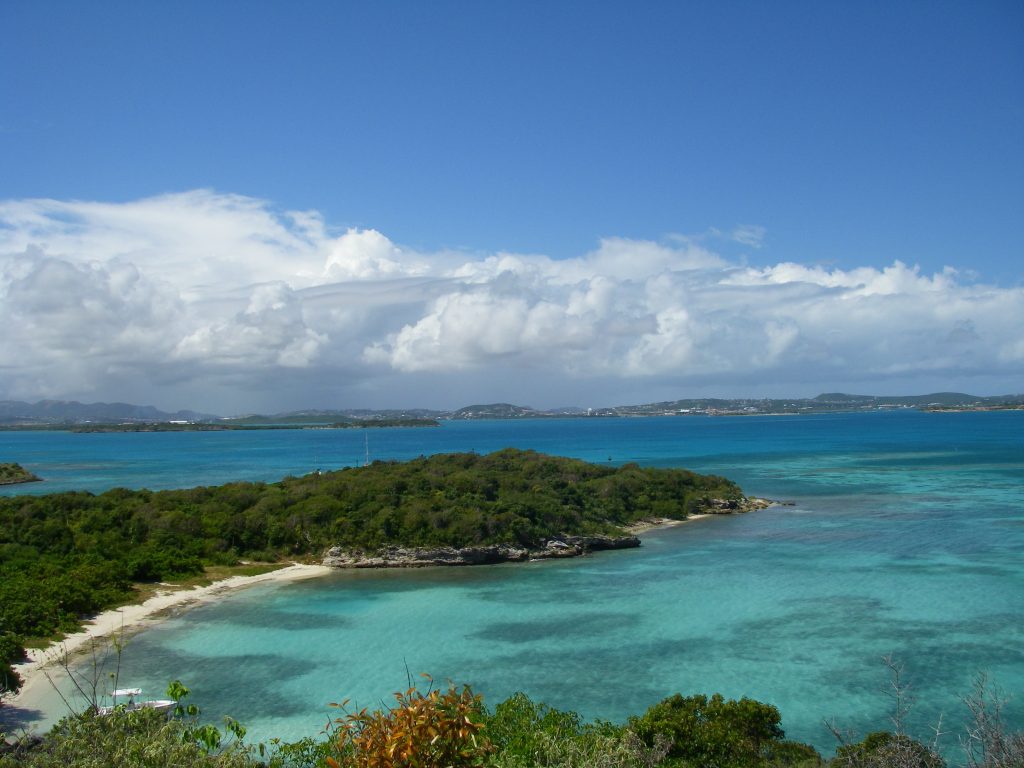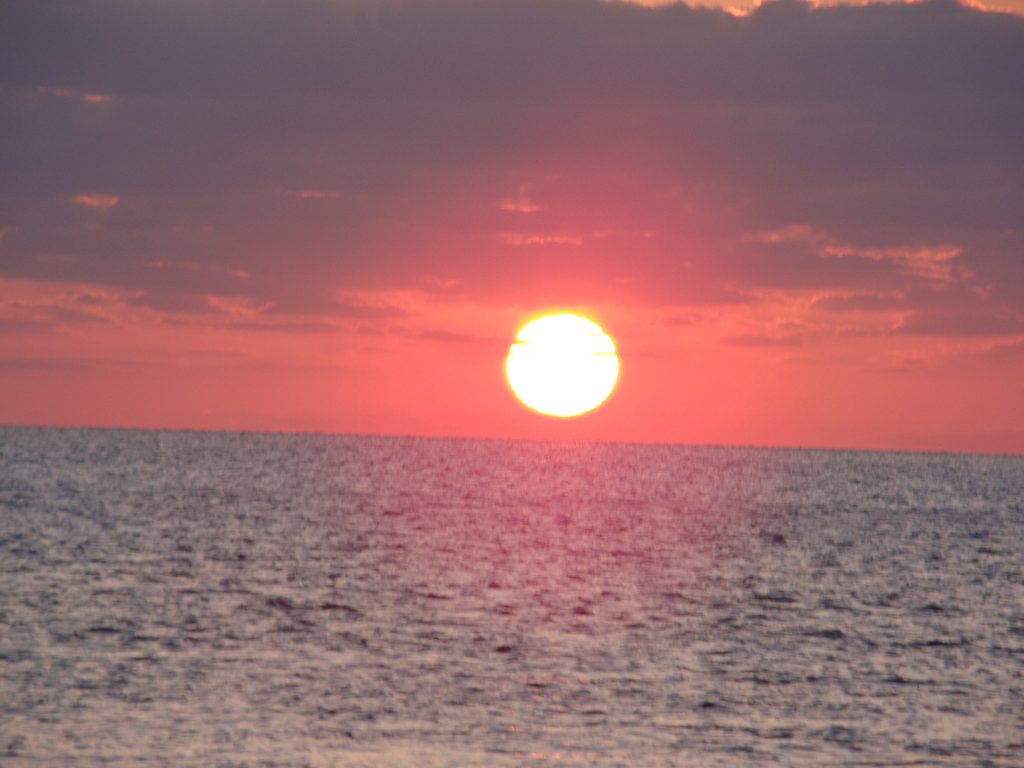Weather Windows
by
James Ewing
The genesis of this article came from a couple of recent passages my partner Ann and I made in “Bees Knees” our 45’ Creekmore designed cutter. The first was a week-long offshore passage from Staniel Cay in the Bahamas to Puerto Rico. The second the short 70 mile hop from the British Virgin Islands to Dutch St. Maarten. On any passage, short or long, the weather you expect is crucial to your planning, comfort and safety. But how do you learn what weather to expect? That’s the key element and it started with a very simple lesson: What we’ve learned is that no matter how we get our weather forecasts – they’re usually wrong.
So let’s talk about how and why they’re wrong, what accounts for the changes, what you can do to get the good information out of the noise, and help yourself avoid any big weather surprises.
PART 1 – How do they know?
The Obvious
It may go without saying, but this is pretty important so I’m going to say it anyway – The earth is ALWAYS covered in Weather. The reason this uniform covering of Weather is so important is that it tricks us, the human species, into thinking we can actually predict it. Ha! This delusion is so deep seated that a quick glance around the globe shows that pretty much every country that bothers with a flag also underwrites a National Weather Service. Each one of these so-called Weather Services tries to predict the weather: the wind, rain, sun, and temperature you experience – and they all fail. They fail because the blanket coverage of Weather we see is really the result of untold gazillions of molecules of nitrogen, oxygen, argon, carbon dioxide, water, propane, perfume, cigarette smoke and cow farts all bumping against each other. To predict the Weather you have to know what each one of these molecules will be doing every second between now and a week from next Tuesday. Yeah, right.
The fun part is that you don’t really give a flying rat’s patootie about the Weather. You want to know about the weather – is it going to be raining or sunny or foggy or cloudy or blowing stink over your little boat when you’re out on the sea. That’s the weather. And to predict it, Bucko, you’re on your own.
The Scam
Here’s the dirty little secret they don’t want you to know – there is nobody in the world that predicts the weather. That, in our modern age, is all done by computer. The “forecasts” you bet your life on are the output of very sophisticated computer programs that are called “models”. In computer terms “sophisticated” means “big, clever, expensive and usually wrong”. These models attempt to simplify the Weather picture by lumping mere untold quadrillions of air molecules into boxes, scattering the boxes across the globe, and then letting the boxes bump up against each other to get an idea of what the weather will be.
So, how good are these models? An analogy might be in order. Remember when you were a kid and you put together a toy doll house, fighter plane, or race car? Remember the difference between the idyllic suburban scene, the Battle of Britain or the finish at Monte Carlo shown on the box and what you ended up with? That’s how good the weather models are.
The bad news is that there is not just one weather model. There’s GFS and UKMET and EURO and NOGAPS and the frighteningly named WW3. Among many others. The models take their input from different observation locations, different – although equally sophisticated – satellites, reports from ships at sea, tea leaves, crystal balls and whatever else they think might work. Then they spit out their forecast. Yes, gone, at last, are the days of reading sheep’s entrails and scattered bones.
However, because all the models were written by different people, for different parts of the world and focusing on different features – they pretty much never agree. To work around this problem “weather analysts” – still more computer programs – create what is called a model consensus. This is a sort-of weighted average of the models where the analyst says “Hmmmmm…GFS has been kind of good lately. Let’s say it’s more correct than the others.” The program is run and *presto*. There’s your forecast.
To make another analogy let’s say, instead of weather possibilities, the models will tell you what city you’ll be in a week from next Tuesday. The results of four models say “New York”, “Miami”, “Los Angeles”, and “Seattle”. Now depending on how the models are weighted some days you might end up with “Chicago”, some days with “Atlanta” and some with “Tucson”. Perfect for planning your trip!
The last step in the process is that a “human” “forecaster” takes a mask, just a device that obscures the entire weather map except the specific area of interest and reads the weather off the map. He or she writes up the weather that shows through the mask as the official forecast and sends it out to be distributed by every means possible to poor, trusting, unsuspecting boaters like me and you.
The truly amazing thing about this way of guessing (there, I’ve said it) the weather is not that it’s wrong so much but that it’s ever right at all.
PART 2 – Ah Hah!
In Part 1 we looked at the way the global Weather is determined and how a local weather forecast is produced that is almost but not quite entirely unlike what will happen. So how do the various weather services get away with being wrong so often. The answer to that is in the percentages.
Consider that real, honest-to-god, scientists and mathematicians have this statement of predictability called the “Butterfly Effect”. Popularly stated it says: “A butterfly flapping its wings in Tibet”, or China or India or some other suitably remote place, “will cause a thunderstorm in Texas a week from next Tuesday.” What this statement means in scientific terms is that the weather is too impossibly complicated to even think about predicting. But predict we try. And as part of that prediction, we cover our bets by stating forecasts in terms of probability of occurrence.
It is a little-known fact, or something I made up, that for a number of years the U.S. National Weather Service supported a Tibetan Monastery to test the Butterfly Effect. This program was suspended when it was determined that 1) the air at Tibet’s altitude was too thin for butterflies to fly in and 2) it was raining a lot in Texas. However, the study continued long enough to generate some hard numbers to use as forecast probabilities. These probabilities pervade the entire forecast but usually are only visible in the “30% chance of rain a week from next Tuesday” sections of the public forecast.
So, let’s start there and delve more deeply into how a weather forecast is ruled by probabilities. What does “30% chance of rain” mean? Does it mean 1) 30% of the area will see some rain; or 2) 100% of the area will see rain 30% of the time; or 3) 100% of the time it will be raining over 30% of the area? You bet! And that’s the out. No matter what happens – sun, sprinkles, or a deluge – it is covered in the 30% chance. But the probabilities go deeper. Our “30% chance of rain” is also a “70% chance of no rain”. In the models that generate the forecasts the actual presence of rain today can either increase or decrease the actual chance of rain tomorrow. So, if you follow a forecast for a while, you will note the probabilities of rain, and conversely no rain, will bob up and down like a cork on the waves with no predictable pattern. For sailors you’ll see the same yo-yo pattern in wind forecasts. Start a week out and the predictions for a given day will swing up and down before settling, a day or two out, at a final prediction. Notice I said “final” and not “accurate”. That is asking too much. This is the Butterfly Effect at work.
When formal weather forecasting started in earnest at the beginning of the 20th Century the forecast made in the evening for tomorrow was right about 80% of the time. Those forecasts were made by people who stuck their heads out the window and said something like “Yup, looks like rain alright.” All the improvements in short term forecasting have come from tools, like satellites and weather radar, which make the window we stick our heads out of effectively bigger. But tomorrow’s weather forecast is still correct about 80% of the time (and, surprisingly, exact only 10% of the time). On top of that each day a forecast is extended beyond tomorrow the accuracy drops by another fairly good chunk. What this means in practice is that the chance of accuracy for our extended forecast for a week from next Tuesday, which is when you will be out to sea in your little boat, is essentially zero.
PART 3 – Save Me!
It’s all up to YOU
With all this bad news what can you do to improve your odds and help ensure a successful and comfortable passage?
First, and this should go without saying, know your boat. This isn’t about sailing and running things it’s about what kind of weather she’s happiest sailing in. Does she like big winds and flat seas? Long rollers with the wind close hauled? A dead run at 20 kt? If the boat is happy, you’ll be happy. If not, ain’t nobody happy. Our boat, Bees Knees, loves 15kts going to weather, hates less than 10kts in any direction, and is happy with big winds anywhere more than 70 degrees apparent. Seas are only a big problem when they’re short and there’s not much wind. Know what your boat likes.
Second, get a feel for what to expect based on the climatology – the historical weather – for the area you’re sailing in. You can find this on Pilot Charts, climatology sections on internet weather sites, weather books, or best of all your own experience in the area. This will narrow the range of weather you can expect. It might not be 100% foolproof – there have been tropical storms in winter – but it will help when you get to the next step.
Lastly, and this might come as a surprise given what I’ve just told you, get any and all weather information – observations, forecasts, charts, maps, anything – that you can lay your hands on. Just remember, like the “Code of the Brethren”, this stuff is more a guideline than an actual forecast. Anything more than five days out is worse than wishful thinking. Those really long-term forecasts might be useful for planning a hypothetical trip but stick to the five-day forecast when working in the real world. When heading offshore I get my weather from a paid service – Chris Parker at the Caribbean Weather Center, the raw GFS model data, and the NOAA Offshore or High Seas text forecast and weather fax products.
Then I put it all together. I first look at the NOAA forecasts. They paint with a very broad brush, and you can get a feel for what large scale features – High and Low pressure systems, fronts, storms, troughs and ridges – are likely to affect your weather. These large-scale features are what ultimately drive your local weather and, although subject to the same uncertainties of precision, can give you an idea of what you might be sailing into. Or what might be catching up to you. Now what do the detailed forecasts and data say about those large-scale features. The question you want to ask is this – Do the details make sense when compared with the large-scale features? For example: Let’s say your look at the large-scale feature shows a strong LOW pressure system passing just north of the area that you’ll be sailing in. The forecasts are all calling for moderate westerly winds as the LOW passes by. But what if the LOW drops to the south a hundred miles or so? Those nice 15 knot winds are now blowing 25-30 and your pleasant reach has changed to large drenching seas and a less-than-optimal day out. What to do? Think back to the section on probabilities. If the LOW is forecast tomorrow it’s probably only 100 to 200 miles away and a sudden shift to the left or right is probably not going to happen. However, if the forecast is for five days from now that LOW might be 1000 to 2000 miles away. Given the extra distance and time and considering the drop in accuracy of longer range forecasts, then a difference in actual versus predicted position of 100 or 200 miles, or more, is not that improbable. In fact it’s likely. Five days from the LOW is not going to be exactly where it is predicted to be. The impact of that uncertainty on you and your boat is yours to control.
“Huh?”, you might ask yourself, “How do I do that?” This is the part where the responsibility shifts. You need to make the jump from being a weather consumer to being a weather analyst. The information you get, regardless of where you are getting it, is all coming from one or two models or from a “model consensus” that your weather forecaster is putting together. That the models are wrong is a given but what you will observe as you start watching the weather a couple of weeks out, is that the forecasts tend to be wrong in the same direction. For example, coming through the sub-tropical latitudes in Florida and the Bahamas this past winter the wind forecasts were 1) typically overstated by 5 knots or so and 2) typically too much North by 20 degrees or so. Once we got into the tropics the errors flipped. We saw consistently more wind than predicted and consistently more from the South than predicted. Watch your forecasts and see how they are differing from what you observe when you stick your head out the window. These trends in errors can be very important. For our passage from the Bahamas to Puerto Rico our analysis gave us the ability to better judge favored tacks and to know when to expect to reef. For our island hopping down the Eastern Caribbean we knew we were going to be sailing closer to more wind than predicted and could set the boat up – before we left our anchorage – and have a much more pleasant time sailing. I’d much rather tie in a reef at anchor than while heeling over and drenched with spray!
Now you have it all. You have the weather forecasts for large scale features and for your local area. You have a feel for the range of possibilities, NOT probabilities, as to how those large features might move and what the impact might be on the local weather where you’ll be. Compare your thoughts on the forecasts to what the climatology shows is typical over the years – How the big systems move, how far south cold fronts go, how the typical storm tracks? This analysis will help refine your realm of weather possibilities and may give you a better feel for what to expect. Next, factor in your observations. Are the forecasts typically for more wind and rain than occurs? How does the actual wind direction compare to that predicted. Lastly, and most importantly, ask yourself “Will the boat be happy in those conditions?” If your answer is “Yes” or “Yes, mostly” then head on out. If your answer is “No” or “Probably not” then STAY IN PORT. The one question you do not want to be asking yourself at sea is “What was I thinking?” Go back to square one and see how things look on a different day. Sometimes 24 or 48 hours can make the difference between a great passage and getting your butt handed to you on a plate.
Part 4 – How and From Where or rather Whom
The Gear
You now know what to do with the weather information. How do you get it? And from whom? The HOW depends on where you’ll be sailing, how far offshore you’ll go, and the WHOM. In any case ALWAYS make sure you have more than one HOW and more than one WHOM. We’ve equipped “Bees Knees” to be able to get weather forecasts from a variety of sources through a variety of equipment so that we can usually count on at least two reliable weather sources.
The absolute minimum, for coastal cruising only, is your trusty VHF radio. Most of North America’s coastal waters, all U.S. possessions, a lot of Europe, Australia’s populated areas, etc., etc. are covered with weather forecasts broadcast continuously on VHF radio. Many other places have scheduled broadcasts, which range from the official weather source through Cruiser’s Nets and local rebroadcasts by businesses and individuals. Use your FM radio to supplement your VHF as most radio stations broadcast the weather as part of the news. Coastal stations usually include marine weather as well.
The VHF/FM solution has one major drawback: its range. Line of sight means, well, your antenna has to see their antenna (ignoring the whole propagation around a sphere thing for now). If not, no signal, no weather. You might be able to count on 40 or 50 miles, these guys use really strong transmitters and really tall antennas, but longer range than that might be hit-or-miss.
For further offshore and with much more flexibility get a marine SSB radio. The marine SSB radio is, to me anyway, borderline JFM. The “J” is “Just” the “M” is “Magic” – figure out the rest. There I am bouncing around on the deep blue sea – and getting email. How cool is that? There have been whole books written on this technology and how to choose and use one so I won’t go into that here. But I will say: 1) get a good one; 2) get one that either has the Amateur Bands (a set of HAM frequencies) open – like the ICOM M802 we have on “Bees Knees” – or that can be opened, either through software (push a couple of very unobvious buttons) or hardware (clip the green wire – wait…..no, the BLUE wire), and 3) get one that you can hook up a PACTOR modem to. I, initially, was not keen on the whole idea of email by SSB. Then at one of those drop-dead-picture-postcard anchorages we frequent a friend showed me the latest NOAA forecast, the latest model runs and a satellite picture to boot and I rushed right out to get mine. Plus you can send and receive email pretty much anywhere in the world. The primary drawback is cost – our setup cost about 4 Grand. Then if you want FREE (yes, cruisers FREE) email and weather access you need to get your Amateur (HAM) Radio Ticket. If you don’t want to get the license there are commercial email services but they’ll set you back a few hundred bucks a year. The other drawback is you probably won’t spring for two radios. So, it’s a single-point-of-failure item – you’re offshore and you lose your antenna or the radio fails or the microphone breaks and you won’t be getting any email, weather, or cruisers nets.
You can also, if you’re going far offshore and want to stay connected, bring along a satellite phone. I did this for a while and ended up selling the phone. It was fairly reliable and did allow some minimal web surfing and email services but was pretty frustrating to use. The data rate was OK for email but everybody’s web pages are designed for high-speed access so you probably won’t be surfing the internet. Globalstar, Iridium, and Imarsat are the main players. If you want to go the Sat Phone route bring the Gold Card – it’s expensive to buy into and the per minute charges are the stuff of legend. That being said, it is nice to be able to pick up the phone and call home from anywhere.
In the satellite line of things you can also get a paid service from XM and Sirius satellite radio broadcasts as a subscription service. This is moderately pricey, about $30/month but you’ll need charting software and a computer or chartplotter to display the weather information. This has the VERY nice feature of sending you real-time (within the last hour or so) updates of actual conditions including things like lightning strikes and storm position and motion. The big drawback from a cruising standpoint is that they only work within a limited distance from the coast. If you are going far afield, like more than 200 miles away from the US coast, you’ll be out of range. But for a coastal trip this is some really nice stuff.
The last technology item I’ll talk about is enhanced Wireless Internet. You’re going to need a computer – but you’re going to need a computer anyway. This technology allows long distance access to wireless internet providers. You can be sitting at anchor and pick up the WiFi signal from a house or marina up to a mile or so away. Basically, the technology works like your built-in wireless network card but at 5 to 10 times the signal strength. We routinely get signals up to a half mile away and can go further if the planets align correctly. This is a great tool for bringing weather information onto your boat. It’s very fast so large satellite images, massive quantities of data, and huge forecast areas are easily handled. It’s not that expensive – waterproof marinized versions can be had for less than $500, you can choose between fixed mount and portable versions, they run off your batteries. It’s a good thing. The only real drawbacks are 1) sometimes there just aren’t any WiFi signals – but that is surprisingly infrequent; and 2) sometimes you’ll have to pay to get on because there are just no kind souls around that leave their network open for cruisers.
The Info
OK, you’ve gotten all your stuff and had to take a job at West Marine to pay for it all. Where do you get your weather data from? Your choices, as talked about earlier, are Government Weather Services, Private Weather Services, and the raw model data. NOAA’s NWC – the weather arm of the U.S. Government – is one of the few that cover the world’s oceans. France does as well. These forecasts are distributed by HF radio – voice and FAX, on the internet, and by VHF if you’re within range. You can also get them sent by email through both subscription and one-time requests. There is an awful lot of information here.
Broadcast and update schedules as well as coverage areas are all detailed on the web. NOAA’s site also has the schedules of ALL the other HF radio broadcasts and content details by ALL the other weather services for the entire rest of the planet. Download that document and update it frequently. Just remember they may not be in English. When in the coastal waters of another country you should be able to pick up the local marine forecast by VHF or FM commercial radio. These may not be continuous broadcasts, but they are usually announced on VHF 16 before broadcast or listed in an area’s cruising guides. There are also a lot of Cruiser’s SSB Weather Nets around the world check them out.
If you use a commercial service or forecaster ask what models they use and how they come up with their forecasts. Much of the weather data available, free or paid, is just repackaged versions of the official NOAA forecasts. Many pay services, XM radio, Sirius’ Weather Channel Marine, etc. are also just delivery services of official forecasts. Know what you’re buying before you pay and, in my opinion, make sure there’s going to be somebody to talk with after you buy.
Now You Have It All
You’ve talked with other cruisers and tried their stuff. You are loaded with gear and data. You have your route planned, you have a fair idea that you’ll be in conditions that your boat will be happy with and, when you get out there, you’ve got a Plan B. It’s one thing to be out there and have conditions deteriorate. It’s another to leave in conditions that are not within your expectations or range of comfort. Remember the one hard and fast rule of marine weather forecasting: You always get to pick the weather you leave in.
